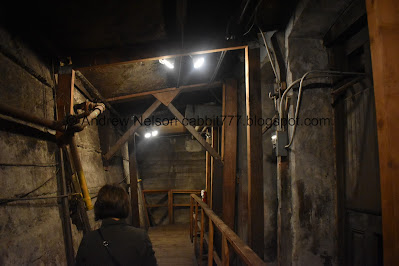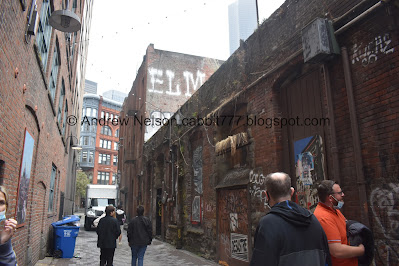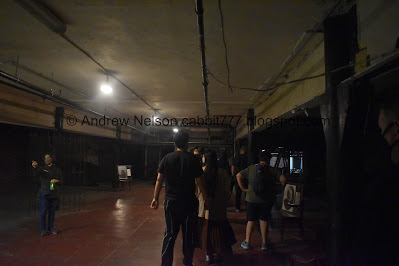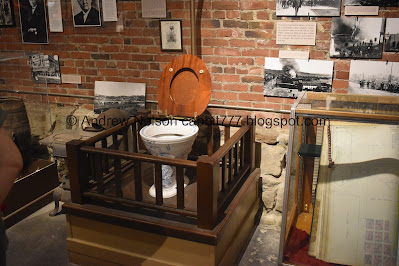Bill Speidels Seattle Underground Tour was a really fascinating tour of the underground Seattle. It was full of history and our tour guide presented it in an interesting and humorous way. I learned way more about the history of plumbing than I expected to. I would have liked to have seen a little more underground, but I get it. You have to negotiate with the city and private property owners, it’s a thing. But I did enjoy what we did.
Location: 614 1st Avenue, in Pioneer Place Park, Pioneer Square
Cost: $22 for adults.
Time Needed: About 75 minutes.
The tour starts with a little history lesson.
Seattle started on soggy tide flats, and during the wet season all the mud and muck (and sewage) would flow around the streets. 25 blocks of mostly wooden structures were destroyed by the Great Seattle Fire in 1889. It was decided afterwards that all new construction should be stone. Then the city erected walls on each side of the streets and filled them in and paved over it. The private businesses were surprised to learn their first floor entrances would become basements.
Then there was a new problem, The city expected the businesses to put in the sidewalks, and vice verse. So now they had streets a level up and open pits. Eventually ladders were put in. After a couple of deaths they city and businesses came to an agreement. The sidewalks were installed, and all the businesses eventually expanded “2nd floor” windows to become doors.
There a lot more to it, but that is the gist of why there is literally an underground city.
Walking over ground to the first location. There is one street crossing where the poor tour guide is very concerned about getting the entire group across before the light switches haha.
We start in an underground bar.
Below ground windows.
The other side.
Another fun story that she shared is how when the flush toilet was invented, the city ordered 100 or so of them. Well, it took a couple of years for that order to be fulfilled, and the city had forgotten all about them.
So the toilets arrive, and they understand generally what to do with the business end, but then they looked at the back and really had no clue.
Eventually someone figured it out and a giant wooden pipe was constructed in the middle of town. that went from the top of the hill, out into the ocean, and they figured out how to connect the toilets to it. The sewage floated out towards Tacoma, and Seattle just went, well that's their problem. Then the tides would change and the pressure of the water flowing back into the pipe created literal sewage geysers out of the toilets.
I want this old conversation couch.
Some of the old photos of the original town, before the fire.
Then we go through the tunnels.
After seeing some piles of debris, I asked the tour guide what kind of effort it took to make this tour walkable for us. She said the the founder convinced some high school kids to help out and get it cleaned up.
Old bricked up store front.
More debris.
Its neat down here.
Back to the ground and through a smaller alley.
Neat old buildings. The guide mentioned the architectural style, but I can’t remember what it is. She did say this neighborhood has one of the largest collections of them still standing. Reviewing Wikipedia, I think it is Victorian interpretations of the Romanesque Revival.
Back underground.
Old pioneer square. They think the lady on the corner was soliciting.
Another fun story. The city decided to get their cut from prostitution so they conducted a census about occupations. They learned they had a ridiculous amount of seamstresses. I forget the reason, but they decided that couldn’t be right so they sent the census taker back to count how many sewing machines he could find. Apparently they found zero. The resulting conclusion was that all the "seamstresses" were prostitutes.
Old sign.
More debris.
Arched ceilings.
Large basement.
Tight squeeze.
More debris.
When they first built the sidewalks, the spaces underneath were still being used as storefronts. So they decided to put in skylights.
With the lights off. I wish I had taken a picture of the room with the lights off. It provided quite a bit of light actually.
Another fun fact: They added manganese dioxide to the glass because at the time it was thought to create clearer glass. They didn’t know that when exposed to sunlight it would turn purple over time.
Old stuff.
Back to the big basement.
The Smith Tower. It is the oldest skyscraper in the city, and at the time of completion in 1914 was the tallest skyscraper outside of NYC at 484 feet. It was the tallest building on the coast until the Space Needle overtook it in 1962.
The guide mentioned the top is a very expensive private penthouse and the ball on the very tip top is a private reading room. It was listed in 2021 for $17.000 a month!
The top side of one of the sky lights.
Smith Tower again.
With it’s penthouse.
The State Hotel with it’s original room rate.
The Pioneer Square Pergola. Was constructed in 1909 as a comfort spot for people waiting for cable cars. Our guide mentioned something about it being built for an earlier worlds fair than the one the Space Needle was built for, however I cannot seem to find anything to corroborate that. Not saying it is not true, I just have yet to find it.
Another skylight.
Merchants Café, Seattle's oldest restaurant which is apparently haunted and offers it’s own basement ghost tour. We ended up having lunch there afterwards.
Old building. Another example of the Victorian interpretations of the Romanesque Revival.
Back to the end of the underground tour we found some old arcade machines.
An old, particularly fancy toilet.
It’s old flush mechanism, with the Crapper’s brand.
Some old photos.
Old machinery.
The fancy toilet was even fancier than I first thought. Its got artwork on the inside too!
Another of the weird, but neat fortune teller machines. I wonder why they are so prominent out here, but I love them.
The stairs leading out show some of the cities nick names.
Better view of Merchants Café.
That was really neat! I am super glad we decided to do it. Very informative, and I really love that they embrace the actual history and talk about the mistakes they made, the corruption, the stubbornness of people and how eventually they learned, and moved forward and built this great city and have some funny stories to tell because of it. I think more of America could learn from that. I highly recommend it!
.jpg)






















































No comments:
Post a Comment